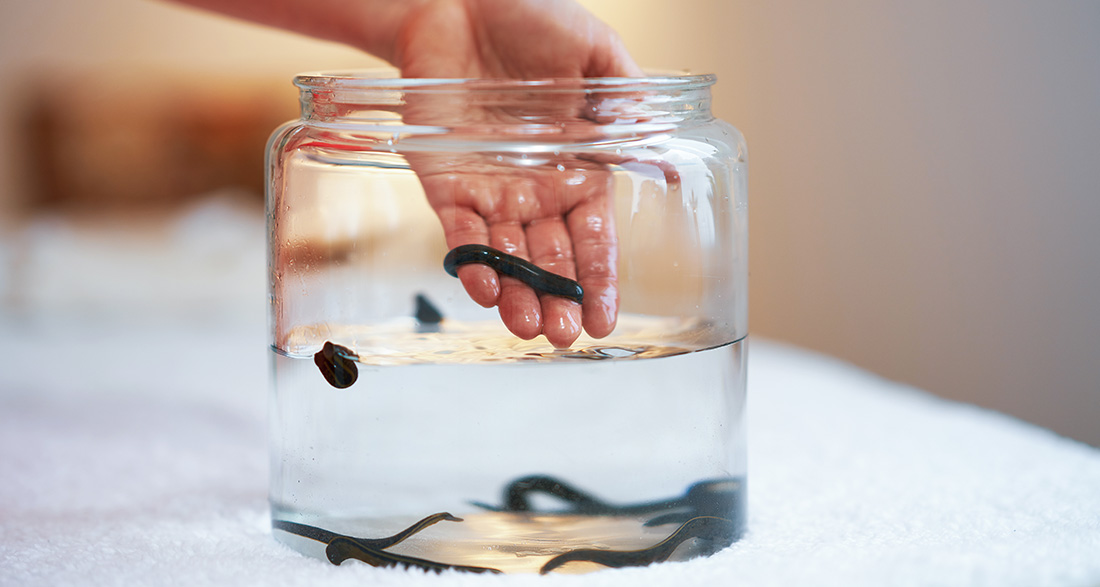Mixed-breed dog Mirko is suffering from nasty arthritis. Whenever it gets colder and more humid, he walks worse, becomes stiffer, and loses his zest for life. Because of this, his owner has decided to have leeches applied.
Leeches, the worm-like crawling creatures from the genus of earthworms, have been used as a healing method worldwide for millennia. In the Middle Ages, the therapy was common, and in the 19th century, it reached such a peak that it significantly reduced the leech population. Today, the effects are researched, and leeches are even approved as medicinal products. The amazing powers of leeches were rediscovered in human medicine in the 1980s when they stimulated blood flow at the wound of a torn-off ear, allowing the body part to regrow. Leeches are used in various medical fields, including accident and plastic surgery.
Hirudo verbana, the medicinal leech, has a suction cup at both ends. At the front, there is a mouth with flexible calcareous teeth. With these, the leech scrapes through the skin. Once engorged, it doubles or triples its weight and length and can grow over 20 centimeters long. In the water, leeches swim through wave-like movements in their bodies, and on land, they use the suction cups to move forward and hold onto surfaces.
The Effect of Leeches
The saliva of the leech is rich in substances that unfold various effects and can, therefore, be used for diverse purposes. The leech releases them into the host’s blood while sucking. They ensure, for example, that the bite is barely noticeable, and the dog does not feel any itching.
One active ingredient in the saliva is Hirudin. It inhibits blood clotting and keeps the bite site open—hence, leech therapy is like a small bloodletting. Other components of the saliva include the anti-inflammatory and anticoagulant Eglin, as well as the antibiotic Hyaluronidase, which also widens blood vessels. Calin has wound-cleansing effects, and Apyrase prevents blood platelets from clumping. Over 100 substances have been identified in the secretions of the worms.
Leech therapy, therefore, has a blood-cleansing and detoxifying effect: saliva stimulates blood circulation, can help transport waste products, has anti-inflammatory, antithrombotic, and likely analgesic effects. The therapy is also said to alleviate cramps, decongest, and relax. Lymph flow is also stimulated. Since leech therapy does not burden internal organs, it is also ideal for older four-legged friends like Mirko.
The Application of Leeches in Dogs
Leeches can be used for a variety of internal and external ailments, helping with inflammation in the body. They sense heat sources and bite particularly well there. Leeches are used for skin conditions such as eczema and abscesses, calluses, and bruises, contusions, poorly healing wounds, scars, and edemas. They also support wound healing in amputation stumps.
In addition, leeches can assist with musculoskeletal disorders: bursitis or bursae, arthritis and arthrosis, or joint deformities. They are also used for tendon and tendon sheath inflammations, ligament and muscle fiber tears, can alleviate nerve irritations and inflammations, and provide relief for spinal conditions such as herniated discs or spondylosis. Leeches can also be used for diseases of the blood and lymph vessels.
Of course, there are contraindications such as anemia or diabetes—hence, it is essential to have the therapy performed by a professional therapist who will only use leeches free from diseases. Leech therapy is usually very well-tolerated, but side effects are possible: such as redness around the bite, allergic reactions, or inflammations. Some dogs may respond with fatigue or mild fever.
The Treatment
Before treatment, Mirko’s owner ensured that he was not washed with a scented shampoo, and also stopped using parasite treatments: she removed the flea collar a week earlier. Because leeches do not bite if they perceive chemicals or other artificial smells.
Medications such as blood thinners or anticoagulants must also be discontinued in consultation with the therapist beforehand. The treatment requires peace and ideally a semi-dark room so that neither the leeches nor the dog are stressed. When the dog lies down, the hungry leeches can be applied to the cleaned skin areas—in Mirko’s case, the joints of the front legs. Depending on the diagnosis and the size of the dog, several leeches may be applied at once. The animals usually attach quickly. They typically suck for between 30 minutes and an hour and drop off when they are finished.
Important:
One must not try to remove the leeches before they have finished their meal. The leech sucks a few milliliters of blood—even after the bite, the wound continues to bleed. This keeps it germ-free. The wound is protected with an absorbent bandage—but bleeding should not be prevented, as it is part of the therapy.
Sometimes improvement is already noticeable after the first treatment; for chronic conditions like Mirko’s arthritis, the therapy can be repeated at intervals of several days.
After treatment, one should ensure that the dog does not scratch at the bite site—crusts or scabs should not be removed. Quiet walks are, of course, possible, but strenuous exercise should be avoided for the time being. A cozy resting place is particularly important so that the dog can rest. For example, Mirko prefers to lie on his orthopedic dog mat.


